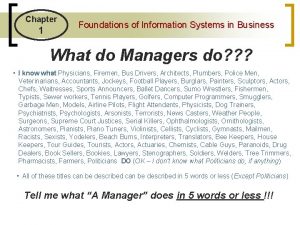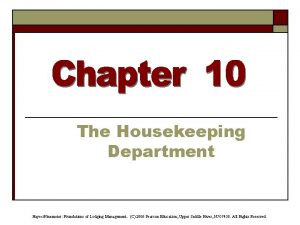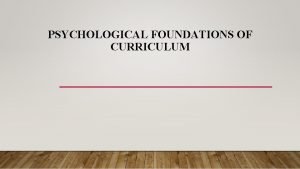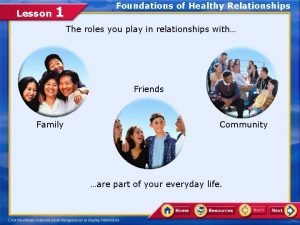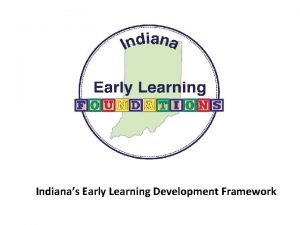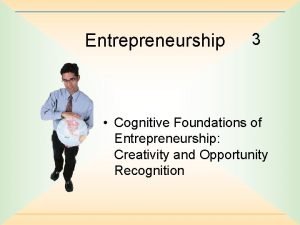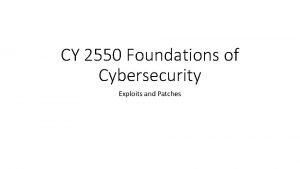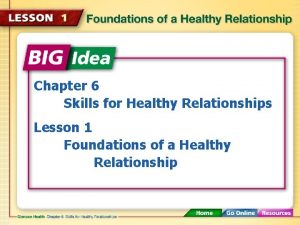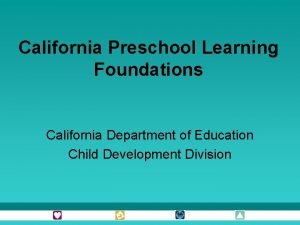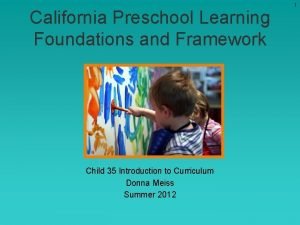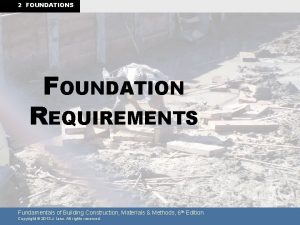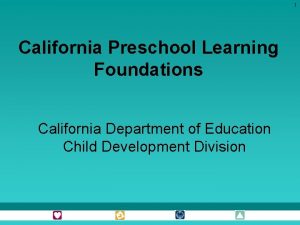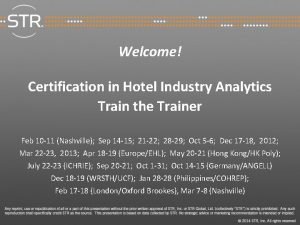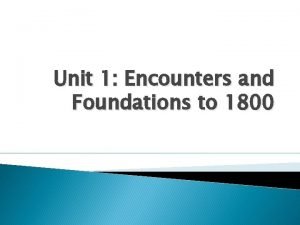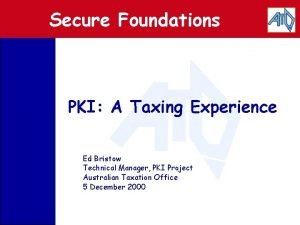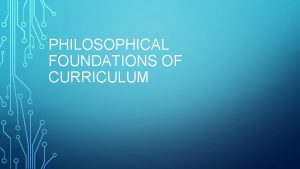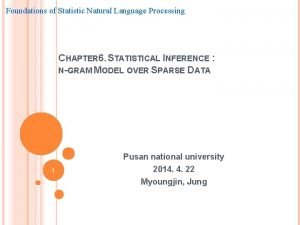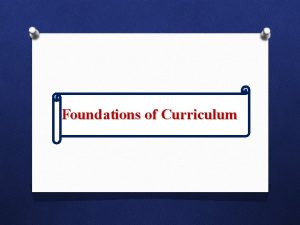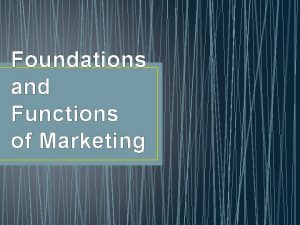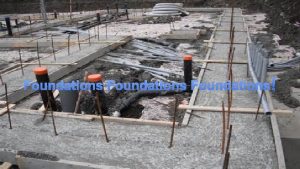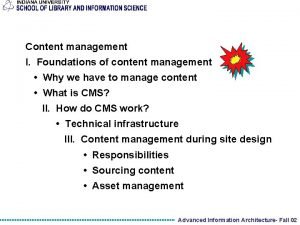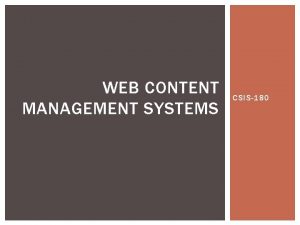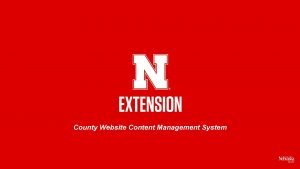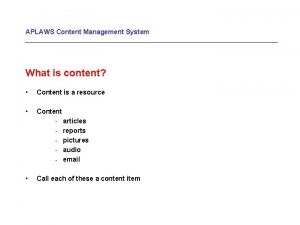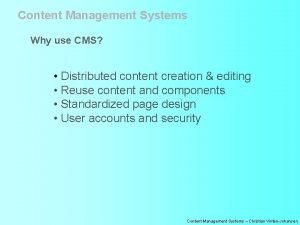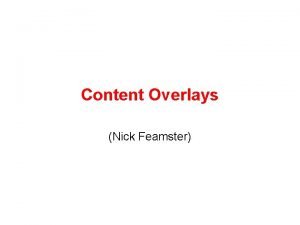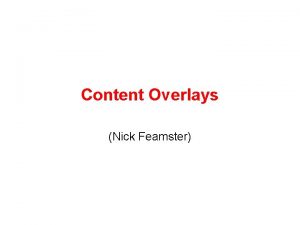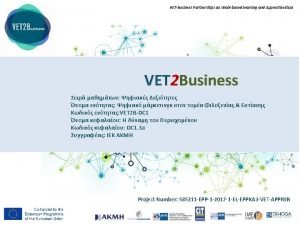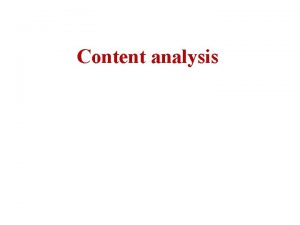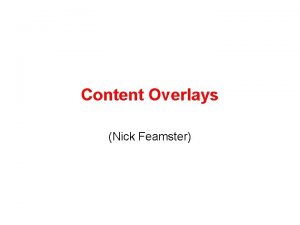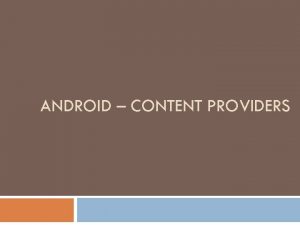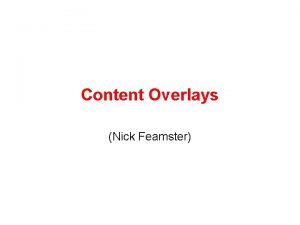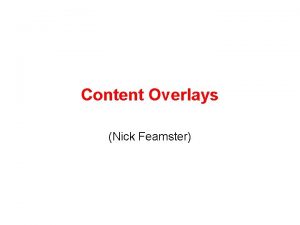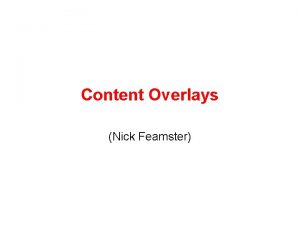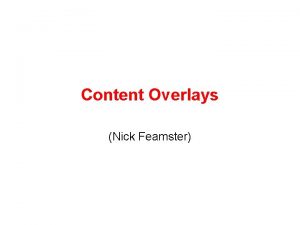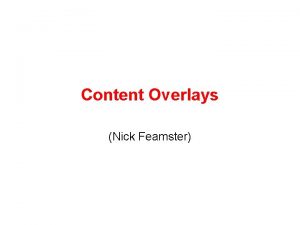Content Management Systems Content management I Foundations of














































- Slides: 46

Content Management Systems

Content management I. Foundations of content management • Why we have to manage content • What is CMS? II. How do CMS work? • Technical infrastructure

I. Foundations of content management II. Why we have to manage content III. Web sites are growing way too quickly IV. Outdated content is typically placed in archives V. use Tools to create new content are becoming easier to VI. VII. to This increases the pool of potential authors There are economic and organizational pressures move more information to the web Inside every small web site is a huge site struggling to get out

How many authors do you have? How many items does each author create or change per month? Ex: news, press releases, short tidbits, calendar events, articles 3 authors @ 5 items a month: 15 updates a month; 180 per year 5 authors @ 10 items a month: 50 updates a month; 600 per year 100 authors @ 12 items a month: 1200 updates a month; 14, 400 per year If the number of authors increases and they post the same amount of content, the number of updates increases

Factors that drive CMS The number of pages on commercial, academic, and government sites continues to increase Users are becoming more demanding and sophisticated People in the organization want changes, updates, and revisions This causes bottlenecks on page production Slowdowns can lead to stale content and inconsistency An unintended consequence of the slowdown is that it’s easier for them to absolve themselves of responsibility for the site Technology changes the way an organization creates and manages content

Old-school content management Many web sites were originally done by hand Hand coding does not scale for large and complex web sites There was an inter-dependency between design, code, and content People on the team would typically do several tasks Changing one part meant changing everything There was no clear production process This was not really necessary with small teams and small sites Issue: what parts of the process can be automated?

The advantage of CMS Content management applies technology to automate the most tedious parts of the old school approach It defines a system for separating site design from the server code The server code is kept separate from the content A CMS provides the means and the opportunity to make a site manageable It will change the workflow of the web team It should result in cost and time savings over time

What is a Content Management System (CMS) ? It refers to products that offer the basic technical infrastructure for developing, organizing and publishing content Three main tools: Asset management interface Used to create and manage content Repository Used to store content Template engine Used to publish content


A wide range of content will be published using the CMS: Simple pages Complex pages, with specific layout and presentation Dynamic information sourced from databases, etc Training materials Online manuals (policy & procedures, HR, etc) General business documents Thousands of pages in total Extensive linking between pages

What do CMS do? CMS automate the process of creating, publishing, and updating Web site content They make maintaining and updating the content of a site easier Content contributors have ability to manage their own content CMS usually have three components A front-end editor for inputting content A back-end system for storing the content A template mechanism to get the content onto the site

Content management involves publishing content with digital tools In its simplest form, it does three things: Asset management Creating, organizing, and managing units of content Preparing content for publishing and dissemination Transformation Presenting the content Deciding on formats and layouts Publishing Delivering the content to the audience Determining the channels for delivery

A good CMS will support Content creation Integrated authoring environment: a seamless and powerful environment for content creators Easy access to the full range of features of the CMS Separation of content and presentation A strict separation allows publishing to multiple formats Authoring must be locally style-based, with formatting applied during publishing Multi-user authoring There must be good version control and tracking

CMS supports Content control Single-sourcing (content re-use) A single page (or even paragraph) can be used in different contexts, or by different user groups This allows managing of different platforms (intranet, internet) from same content source Metadata creation Capturing metadata (creator, subject, keywords) is critical Powerful linking Authors create stable cross-links among pages

CMS supports Content control Non-technical authoring Authors are not required to use HTML (or other markup) when creating pages Content management Version control & archiving Necessary for legal accountability, backup and disaster recovery Workflow Decentralized content creation relies on a workflow model, that is customized, and resilient against organizational change

CMS supports Content management Security Adequate security levels and audit trails must be in place to protect integrity of content Integration with external systems A CMS will only be successful if it can be cleanly integrated with existing business systems Reporting It must provide an extensive range of reports, for users and administrators

CMS supports Publishing Stylesheets Final appearance is controlled through the use of stylesheets Page templates Specifies overall page layout with a non-technical interface Extensibility Allows integration of code to provide additional publishing functionality

CMS supports Publishing Support for multiple formats It must publish to multiple formats (HTML, print, PDF, WAP Allows for additional formats, as new standards evolve Personalisation Different information is presented based on either user profiles, or metadata in the source content Usage statistics It provides comprehensive usage statistics to be gathered, and displayed

CMS supports Presentation Usability The system should produce pages that have ease of use, learnability and efficiency Accessibility It must conform to W 3 C Web Accessibility Initiative and other relevant standards Cross browser support The pages must be viewable in all major web browsers

CMS supports Presentation Speed Page size must be limited to ensure that load times are acceptable for users Valid HTML All pages must conform to the current HTML specification Metadata All pages must provide sufficient metadata to allow effective indexing and searching

CMS supports Contracts and business Training The vendor must list the training materials that exist for the CMS, and the training services that they can provide Documentation It must be supported by adequate documentation for users, administrators and developers Maintenance agreements The vendor must outline preferred support arrangements (service level agreements and upgrade processes)

CMS supports Contracts and business Skills required What skills and knowledge will be required within your organization to customize and maintain the CMS? Cost Both fixed costs for the CMS, and per-user ("per-seat”) Scalability The load levels that it supports, and additional resources for increased usage IT constraints Specify pre-existing hardware or software that the CMS must interface with, or run on

CMS involve workflow management, linking work practices and the CMS infrastructure It is a predefined series of tasks through which content is created and published It describes the progression of content through the asset management, transformation, and publishing activities It makes work processes explicit and systematic It applies rules to users and tasks to manage a process A good workflow tool automates reminders to move content assets through the entire process It generates logs so that we understand what is going on, what the status of each content item is, and where the bottlenecks exist

CMS are sociotechnical systems composed of the people involved (authors, editors, and developers) and the technology that supports them Content management is a group activity, and requires cooperation to succeed It involves coordination and collaboration Business processes involved in the production of the web site have to be examined It is important to understand what people do in the production process Putting in place a technology infrastructure that will support that collaboration is not a trivial activity

It also includes the broader social and organizational context in which these tools are used This always involves the business environment of the organization The goals, culture, and decision-making processes must be taken into account It typically centers on the purposes of the web site Organizations and people use web sites to communicate CMS supports the technical aspects of digital communication It is intended to help people get their jobs done faster and more efficiently

Planning and implementing CMS is a serious high-level strategic activity Selecting a CMS is typically a job for CTOs or IT department heads because of the high cost of the tools It is important for the IA to have input into this process CMS affects many people in an organization It will change their workflows and there will be a learning curve It will lead to policy changes There is work to be done to convince the stakeholders that such a system is necessary These systems are new enough that the impacts on organizations is often not widely understood

How CMS work Technical infrastructure Content creation Users add content via a browser-based interface The interface is similar to the web site It typically has rich text editing capabilities Asset management is handled within this interface Users edit existing content, compare versions of content, and to approve content for publication Some systems are integrated with apps such as Office or Dreamweaver

Some provide custom client-side applications A richer editing environment allowing administrative tasks An application programming interface (API) allows users to add or manipulate content stored via scripts Workflow helps manage the flow of content through this technical structure IA is aware of and can approve what happens throughout Version control helps people track changes to the content allowing management of change The administrator assigns users and groups to certain roles and actions User access control levels (ACL)

Repository The repository can be a database, a closed file system, or a mixture of both It can be virtual One interface can provide access to numerous backend data sources It stores content and any associated metadata Metadata enables a range of content management functions Allows the CMS to deliver more precise searches, It can generate topic-based navigation and create links to related pages It can track workflow status

Publishing A template engine applies design elements to content, in order to produce the desired output document The templates themselves usually contain placeholders for content from the repository More powerful schemes can allow inline code to be interpreted in the templates Link management refers to how the tool tracks and maintains internal links and site navigation This can be driven by an internally maintained glossary of unique content Ids Other systems handle it by referring to a user-created site structure, which is also used to create navigation

Static publishing Pages are created and uploaded Dynamic publishing Content is uploaded to the database When a request for a web page is received, the template engine publishes the content using the template A dynamic server requires more processing power, but is useful for presenting constantly changing or frequently updated content

CMS range from expensive, enterprise-wide packages to open source software Vignette (300 K): CM for rapid building, managing and deployment of web apps for real time enterprise http: //www. vignette. com/ Interwoven (300 K): manage enterprise content across internally and externally facing internet-based business applications, http: //www. interwoven. com/ Microsoft’s CMS server ($43, 000 per server processor): allows you to quickly and efficiently build, deploy, and maintain content-rich Web sites http: //www. microsoft. com/cmserver/

More CMS Manila (1 K): allows writers, designers and graphics people to manage full-featured, high performance Web sites through an easy-to-use browser interface http: //manila. userland. com/ Zope (Free/1 K): an open source platform for building content management systems http: //www. zope. com/ Tiki. Wiki (Free): an open source platform to create web applications, Sites, Portals, Intranets and Extranets and web-based collaboration tools http: //tikiwiki. org/tiki-view_articles. php

http: //www. boxesandarrows. com/archives/managing_the_complexity_of_content_manag ement. php

http: //www. boxesandarrows. com/archives/managing_the_complexity_of_content_manag ement. php

Recommendations from Lombardi’s study Keep the team small to control communication and complexity Don’t try to fix everything at once Only build what you need CMS have lots of features and it’s easy to get distracted Choose that provide savings in efficiency Minimize the number of templates used in the CMS with a good IA Don’t lose sight of the content (creation and/or reformatting)

CMS Comparison

CMS Comparison

CMS Comparison

CMS Comparison

CMS Comparison

A simple CMS: Mambo

A Simple CMS: Mambo

A Simple CMS: Mambo

A Simple CMS: Mambo

A Simple CMS: Mambo
 Foundation of information system
Foundation of information system Content management system capabilities
Content management system capabilities Foundations of lodging management
Foundations of lodging management Foundations of multinational financial management
Foundations of multinational financial management Carrier content vs real content
Carrier content vs real content Dynamic content vs static content
Dynamic content vs static content Decision support systems and intelligent systems
Decision support systems and intelligent systems Principles of complex systems for systems engineering
Principles of complex systems for systems engineering Embedded systems vs cyber physical systems
Embedded systems vs cyber physical systems Engineering elegant systems: theory of systems engineering
Engineering elegant systems: theory of systems engineering Idempotent law example
Idempotent law example The foundations logic and proofs
The foundations logic and proofs Preschool curriculum framework volume 1
Preschool curriculum framework volume 1 Behaviorism vs humanism
Behaviorism vs humanism New foundations foster care
New foundations foster care What are the three c's of healthy relationships
What are the three c's of healthy relationships Indiana learning foundations
Indiana learning foundations History and geography the foundations of culture
History and geography the foundations of culture What are biographical characteristics?
What are biographical characteristics? Foundations of business 5th edition
Foundations of business 5th edition Cognitive foundations of entrepreneurship
Cognitive foundations of entrepreneurship Cognitive foundations of entrepreneurship
Cognitive foundations of entrepreneurship Cy 2550 northeastern
Cy 2550 northeastern Chapter 6 skills for healthy relationships lesson 1
Chapter 6 skills for healthy relationships lesson 1 Chapter 2 foundations of resident care
Chapter 2 foundations of resident care Social learning theory in organisational behaviour
Social learning theory in organisational behaviour Preschool learning foundations
Preschool learning foundations California preschool learning foundations volume 1
California preschool learning foundations volume 1 Aohs foundations of anatomy and physiology 1
Aohs foundations of anatomy and physiology 1 Aohs foundations of anatomy and physiology 2
Aohs foundations of anatomy and physiology 2 Foundations and earth retaining structures
Foundations and earth retaining structures Preschool learning foundations volume 3
Preschool learning foundations volume 3 Sigma simplicity
Sigma simplicity Pearson education limited 2015
Pearson education limited 2015 Building the right foundations/fundamentals
Building the right foundations/fundamentals Preschool learning foundations social emotional
Preschool learning foundations social emotional California preschool learning foundations
California preschool learning foundations Hotel math fundamentals
Hotel math fundamentals Encounters and foundations to 1800
Encounters and foundations to 1800 Secure foundations
Secure foundations Philosophical foundation of curriculum
Philosophical foundation of curriculum Mathematical foundations of computer graphics and vision
Mathematical foundations of computer graphics and vision Language
Language What are the 3 foundations of curriculum?
What are the 3 foundations of curriculum? Preschool learning foundations math
Preschool learning foundations math 4 foundations of marketing
4 foundations of marketing Pencounters
Pencounters
